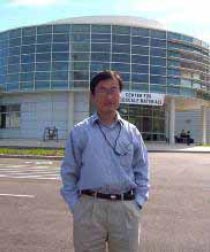Dr. Yugang Sun
The PhysOrg article Palladium Nanoparticle Electrodeposition on Nanotubes Results in New Flexible Hydrogen Sensors said
“In comparison to current hydrogen sensors, which are rigid and use expensive, pure palladium, Argonne’s new sensors are flexible and use single-walled carbon nanotubes (SWNTs) as supports to improve efficiency and reduce cost.Yugang Sun and Hau Wang from ANL’s Center for Nanoscale Materials fabricated the new sensing devices by using a two-step process of chemical vapor deposition and dry transfer printing. This process allows the film of nanotubes to form on the plastic, after which the palladium nanoparticles are deposited on the SWNTs to make the sensors.
According to Sun, these sensors exhibit excellent sensing performance in terms of high sensitivity, fast response time, and quick recovery, while the use of plastic sheets reduces their overall weight and increases their mechanical flexibility and shock resistance.”
Yugang Sun, Ph.D. is Assistant Scientist, Nanophotonics, Argonne National Laboratory, Center for Nanoscale Materials.
Yugang’s research focuses on the design and synthesis/fabrication of functional nanostructures made of metals, semiconductors, oxides, and their hybrids/composites. His aim is to control physical parameters (e.g., dimension, composition, shape, structure, etc.) of these nanostructures and to investigate their corresponding unique properties in the context of optics, electronics, optoelectronics, and mechanics as well as their responses toward interesting biological and chemical species.
These fundamental studies work with forward-looking engineering efforts and lead to the fabrication of unconventional devices, such as flexible electronics, sensory skins, intelligent surgical gloves, etc. His current interests also include the use of plasmon-enhanced phenomena on the surfaces of noble metal nanostructures to exploit energy-oriented directions. For example, they include the use of solarplasmonics and plasmonics-assisted reactions, through intensive collaboration with scientists in the Nanophotonics group of the CNM (Center for Nanoscale Materials).
Yugang coauthored Structural forms of single crystal semiconductor nanoribbons for high-performance stretchable electronics, Heterogeneous Three-Dimensional Electronics by Use of Printed Semiconductor Nanomaterials, Bendable GaAs Metal-Semiconductor Field Effect Transistors Formed with Printed GaAs Wire Arrays on Plastic Substrates, Synthesis and Optical Properties of Nanorattles and Multiple- Walled Nanoshells/Nanotubes Made of Metal Alloys, Photolithographic Route to the Fabrication of Micro/Nanowires of III-V Semiconductors, and Transformation of Silver Nanospheres into Nanobelts and Triangular Nanoplates through a Thermal Process.
Yugang earned his B.S. and Ph.D. degrees in chemistry from the University of Science and Technology of China (USTC) in 1996 and 2001, respectively. He holds the patent Printable Semiconductor Structures and Related Methods of Making and Assembling.
Read his LinkedIn profile.
